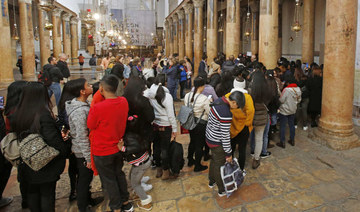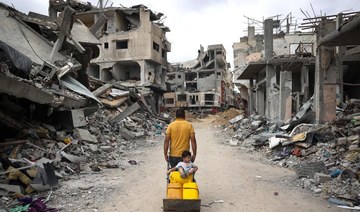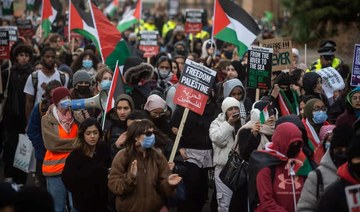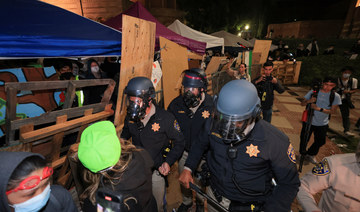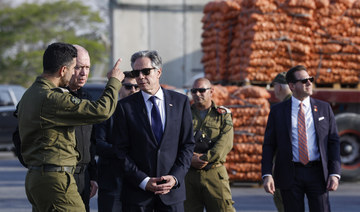BETHLEHEM, West Bank: Business is bouncing back in Bethlehem after two years in the doldrums during the coronavirus pandemic, lifting spirits in the traditional birthplace of Jesus ahead of the Christmas holiday.
Streets are bustling with tour groups. Hotels are fully booked, and months of deadly Israeli-Palestinian fighting appears to be having little effect on the vital tourism industry.
Elias Arja, head of the Bethlehem hotel association, said that tourists are hungry to visit the Holy Land’s religious sites after suffering through lockdowns and travel restrictions in recent years. He expects the rebound to continue into next year.
“We expect that 2023 will be booming and business will be excellent because the whole world, and Christian religious tourists especially, they all want to return to the Holy Land,” said Arja, who owns the Bethlehem Hotel.
On a recent day, dozens of groups from virtually every continent posed for selfies in front of the Church of the Nativity, built on the grotto where Christians believe Jesus was born. A giant Christmas tree sparkled in the adjacent Manger Square, and tourists packed into shops to buy olive wood crosses and other souvenirs.
Christmas is normally peak season for tourism in Bethlehem, located in the Israeli-occupied West Bank just a few miles southeast of Jerusalem. In pre-pandemic times, thousands of pilgrims and tourists from around the world came to celebrate.
But those numbers plummeted during the pandemic. Although tourism hasn’t fully recovered, the hordes of visitors are a welcome improvement and encouraging sign.
“The city became a city of ghosts,” said Saliba Nissan, standing next to a manger scene about 1.3 meters (4 feet) wide inside the Bethlehem New Store, the olive wood factory he co-owns with his brother. The shop was filled with Americans on a bus tour.
Since the Palestinians don’t have their own airport, most international visitors come via Israel. The Israeli Tourism Ministry is expecting some 120,000 Christian tourists during the week of Christmas.
That compares to its all-time high of about 150,000 visitors in 2019, but is far better than last year, when the country’s skies were closed to most international visitors. As it has done in the past, the ministry plans to offer special shuttle buses between Jerusalem and Bethlehem on Christmas Eve to help visitors go back and forth.
“God willing, we will go back this year to where things were before the coronavirus, and be even better,” said Bethlehem’s mayor, Hanna Hanania.
He said about 15,000 people attended the recent lighting of Bethlehem’s Christmas tree, and that international delegations, artists and singers are all expected to participate in celebrations this year.
“Recovery has begun significantly,” he said, though he said the recent violence, and Israel’s ongoing occupation of the West Bank, always have some influence on tourism.
Israel captured the West Bank in the 1967 Mideast war. The internationally recognized Palestinian Authority has limited autonomy in parts of the territory, including Bethlehem.
The Christmas season comes at the end of a bloody year in the Holy Land. Some 150 Palestinians and 31 Israelis have been killed in Israeli-Palestinian fighting in the West Bank and east Jerusalem this year, according to official figures, making 2022 the deadliest year since 2006. Israel says most of the Palestinians killed were militants, but stone-throwing youths and some people not involved in the violence have also been killed.
The fighting, largely concentrated in the northern West Bank, reached the Bethlehem area earlier this month, when the Israeli army killed a teenager in the nearby Deheishe refugee camp. Palestinians held a one-day strike across Bethlehem to protest the killing.
Residents, however, seem determined not to allow the fighting to put a damper on the Christmas cheer.
Bassem Giacaman, the third-generation owner of the Blessing Gift Shop, founded in 1925 by his grandfather, said the pandemic was far more devastating to his business than violence and political tensions.
Covered in sawdust from carving olive-wood figurines, jewelry and religious symbols, he said it will take him years to recover. He once had 10 people working for him. Today, he employs half that number, sometimes less, depending on demand.
“The political (situation) does affect, but nothing major,” Giacaman said. “We’ve had it for 60-70 years, and it goes on for a month, then it stops, and tourists come back again.”
Bethlehem welcomes Christmas tourists after COVID-19 pandemic lull
https://arab.news/5p5hq
Bethlehem welcomes Christmas tourists after COVID-19 pandemic lull
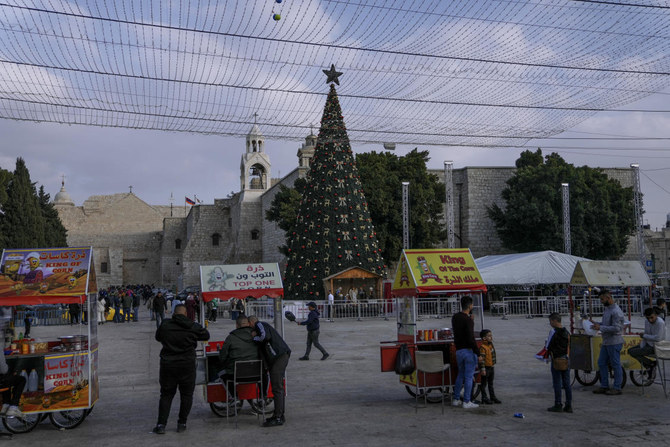
- Tourists are hungry to visit the Holy Land’s religious sites after suffering through lockdowns and travel restrictions in recent years
Rebuilding bombed Gaza homes may take 80 years, UN says

- If construction materials are delivered five times as fast as in the last crisis in 2021, re-construction could be done by 2040
- Palestinian data shows that around 80,000 homes have been destroyed
GENEVA: Rebuilding homes in the Gaza Strip could drag into the next century if the pace follows the trend of previous conflicts, according to a UN report released on Thursday.
Nearly seven months of Israeli bombardment have caused billions of dollars in damage, leaving many of the crowded strip’s high-rise concrete buildings reduced to heaps, with a UN official referring to a “moonscape” of destruction.
Palestinian data shows that around 80,000 homes have been destroyed in a conflict triggered by Hamas fighters’ deadly attacks on southern Israel on Oct. 7. Israeli strikes have killed tens of thousands of Palestinians.
The assessment, released by the UN Development Programme, said Gaza needs “approximately 80 years to restore all the fully destroyed housing units.”
However, in a best-case scenario in which construction materials are delivered five times as fast as in the last crisis in 2021, it could be done by 2040, the report said.
The UNDP assessment makes a series of projections on the war’s socioeconomic impact based on the duration of the current conflict, projecting decades of ongoing suffering.
“Unprecedented levels of human losses, capital destruction, and the steep rise in poverty in such a short period of time will precipitate a serious development crisis that jeopardizes the future of generations to come,” said UNDP Administrator Achim Steiner in a statement.
In a scenario where the war lasts nine months, poverty is set to increase from 38.8 percent of Gaza’s population at the end of 2023 to 60.7 percent, dragging a large portion of the middle class below the poverty line, the report said.
Doubts grow over Gaza truce plan

- Israel still waiting for Hamas’s response to the latest proposal
GAZA: Doubts grew on Thursday over the fate of a Gaza truce plan that, as the week began, had raised hopes of an end to nearly seven months of war between Israel and Palestinian Hamas militants.
Israel was still waiting for Hamas’s response to the latest proposal, said an Israeli official not authorized to speak publicly.
Mediators have proposed a deal that would halt fighting for 40 days and exchange Israeli hostages for potentially thousands of Palestinian prisoners, according to details released earlier by Britain.
Any such deal would be the first since a one-week truce in November saw 80 Israeli hostages exchanged for 240 Palestinian prisoners.
The war started with Hamas’s October 7 attack on southern Israel that resulted in the deaths of 1,170 people, mostly civilians, according to an AFP tally based on Israeli official figures.
Israel estimates that 129 captives seized by militants during their attack remain in Gaza, but the military says 34 of them are dead.
Israel’s retaliatory offensive, vowing to destroy Hamas, has killed at least 34,596 people in Gaza — mostly women and children — including 28 over the past day, according to the health ministry in the Hamas-run territory.
Much of Gaza has been reduced to a grey landscape of rubble. The debris includes unexploded ordnance that leads to “more than 10 explosions every week,” with more deaths and loss of limbs, Gaza’s Civil Defense agency said on Thursday.
Hampered aid
Humanitarians are struggling to get aid to Gaza’s 2.4 million people, hundreds of thousands of whom have fled to Rafah, the territory’s southernmost point, the United Nations says.
Senior Hamas official Osama Hamdan told AFP late Wednesday that the movement’s position on the truce proposal was “negative” for the time being.
The group’s aim remains an “end to this war,” senior Hamas official Suhail Al-Hindi said — a goal at odds with the stated position of Israel’s Prime Minister Benjamin Netanyahu.
Regardless of whether a truce is reached, Netanyahu vows to send Israeli troops into Rafah against Hamas fighters there. US officials reiterated their opposition to such an operation without a plan to protect the civilians.
US Secretary of State Antony Blinken has urged the Islamist movement to accept the truce plan.
“Hamas needs to say yes and needs to get this done,” Blinken said Wednesday while in Israel on his latest Middle East mission.
In early April there had also been initial optimism over a possible truce deal, only to have Israel and Hamas later accuse each other of undermining negotiations.
Following a meeting with Blinken, Israel’s opposition leader Yair Lapid insisted that Netanyahu “doesn’t have any political excuse not to move to a deal for the release of the hostages.”
Netanyahu faces regular protests in Israel calling on him to make a deal that would bring home the captives. On Thursday protesters set up over-sized photos of women hostages outside Netanyahu’s Jerusalem residence. In Tel Aviv they again blocked a highway.
Israel protests
Demonstrators accuse the prime minister, who is on trial for corruption charges he denies, of seeking to prolong the war.
Fallout from the Gaza fighting has spread throughout the Middle East, including to the Red Sea region where commercial shipping has been disrupted.
US and allied warships have regularly shot down suspected drones and missiles fired by Iran-backed Yemeni rebels who say they act in solidarity with Palestinians.
Criticism of the war has intensified in the United States, Israel’s top military supplier.
Demonstrations have spread to at least 30 US universities, where protesters have often erected tent encampments to oppose Gaza’s ever-increasing death toll.
Talks on a potential deal to pause the bloodiest-ever Gaza war have been held in Cairo involving US, Egyptian and Qatari mediators.
Mairav Zonszein, senior analyst at the International Crisis Group think-tank, said he was pessimistic Hamas would agree to a deal “that doesn’t have a permanent ceasefire baked into it.”
A source with knowledge of the negotiations said on Wednesday that Qatari mediators expected a response from Hamas in one or two days.
The source said Israel’s proposal contained “real concessions” including a period of “sustainable calm” following an initial pause in fighting, and the hostage-prisoner exchange.
The source said Israel’s withdrawal from Gaza remained a likely point of contention.
Egypt’s mediation
Egypt was involved in a flurry of calls “with all the parties,” the country’s state-linked Al-Qahera News reported, citing a high-level Egyptian official who spoke of “positive progress.”
Martin Griffiths, the UN aid chief, this week said “improvements in bringing more aid into Gaza” cannot be used “to prepare for or justify a full-blown military assault on Rafah.”
The US military since last week has been building a temporary pier off Gaza to assist aid efforts. The pier is now more than half finished, the Pentagon said on Wednesday.
In Khan Yunis city near Rafah, foreign aid and borrowed equipment helped to “almost completely” restore the emergency department at Nasser Medical Complex, said Atef Al-Hout, the hospital director.
Intense fighting raged in mid-February around the hospital, which Israeli tanks and armored vehicles later surrounded.
Israel’s army on Thursday said that among strikes over the previous day, a fighter jet hit “a military structure in central Gaza.”
Witnesses and an AFP correspondent on Thursday reported air strikes in Khan Yunis and artillery bombardment in the Rafah area, while militants and Israeli troops battles in Gaza City to the north.
Also in north Gaza, workers unloaded boxes of aid at Kamal Adwan hospital where Alaa Al-Nadi’s son lay motionless in the intensive care unit, his head almost completely swathed in bandages.
Nadi, her own arm bandaged after they were wounded in a strike, feared the hospital’s power could go out, cutting the boy’s oxygen and killing him.
“I call on the world to transfer my son for treatment abroad. He is in a very bad condition,” she said, breaking down in tears.
Iraq students rally for Gaza and US campus protests
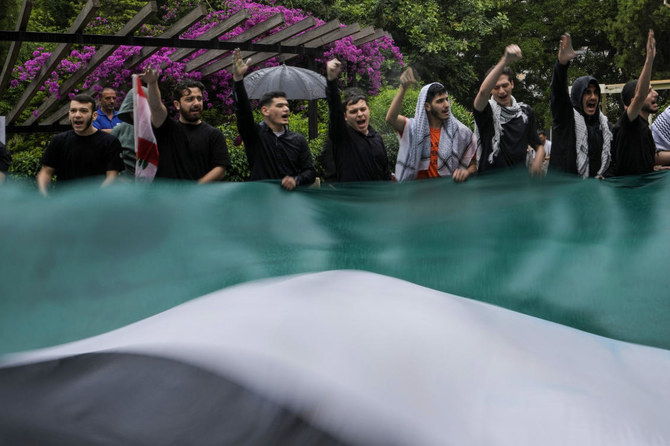
- Students at Al-Nahrain University waved the Palestinian and Iraqi flags
- Iraq does not recognize Israel while all Iraqi political factions support the Palestinian people
BAGHDAD: Dozens of Iraqi university students and professors rallied Thursday at a Baghdad campus in solidarity with Gaza and pro-Palestinian protests at US universities, AFP correspondents said.
Iraqi Education Minister Naeem Al-Aboudi earlier this week expressed his support for the “free voices in universities” around the world, and called for protests in solidarity with the embattled Gaza Strip.
Students at Al-Nahrain University waved the Palestinian and Iraqi flags.
“With all that is happening to our people in Gaza... of course I must be among the first to come to raise our voice,” student Aya Kader, 20, said.
“It is very positive to see the Palestinian flag being waved at American universities,” she said.
Weeks-long pro-Palestinian protests that have swept campuses across the United States have “encouraged us,” she added.
Students and professors also carried banners calling for a “free Palestine,” with some wearing the keffiyeh scarf that has long been a symbol of the Palestinian cause.
“We are here to tell them to stop the killing and to thank the free voices around the world,” said Professor Jomaa Salman, head of the engineering faculty.
“If the storming of Columbia University had happened in another country, especially in a third world country, they would have moved heaven on earth.”
The Iraqi embassy in Washington called Wednesday for “restraint, calm, respect for human rights and peaceful expression” as unrest over Israel’s war in Gaza simmered on US campuses.
Iraq does not recognize Israel while all Iraqi political factions support the Palestinian people.
In 2019, popular protests broke out in Iraq against the ruling establishment, and a security crackdown left more than 600 people killed.
The United States is Israel’s largest military supplier.
Student protesters on American campuses say they are expressing solidarity with Palestinians in the war-devastated Gaza Strip, prompting large-scale police arrests.
The Gaza war broke out after the unprecedented October 7 Hamas attack on southern Israel which resulted in the death of 1,170 people, mostly civilians, according to an AFP tally based on Israeli official figures.
Vowing to destroy Hamas, Israel retaliated with a massive offensive that has killed at least 34,596 people in Gaza, mostly women and children, according to the health ministry in the Hamas-run territory.
Militants also seized hostages during the attack, estimating that 129 of them remain in Gaza, including 34 the military says are dead.
UAE FM discusses Gaza with Israel’s opposition leader
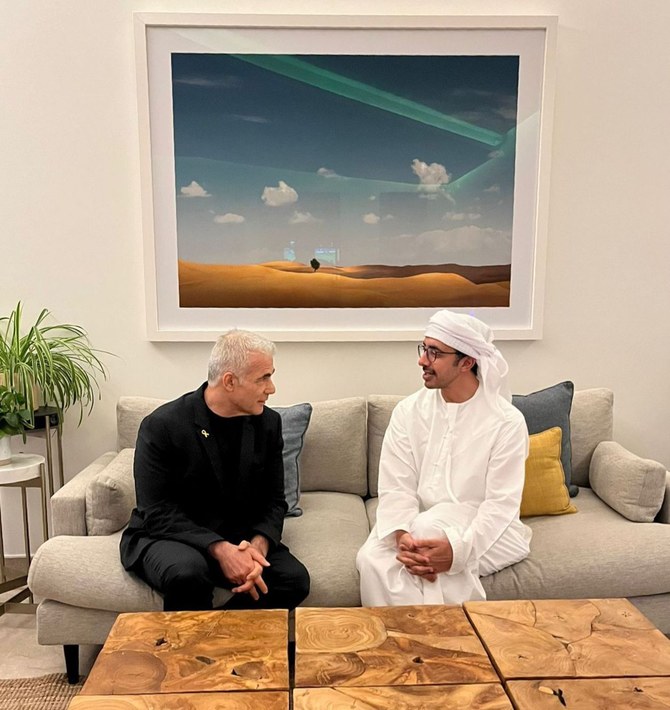
- Sheikh Abdullah stressed the need to restart talks on the two-state solution in Palestine
ABU DHABI: The UAE’s Foreign Minister Sheikh Abdullah bin Zayed Al-Nahyan held discussions on developments in Gaza with Israel’s opposition leader Yair Lapid in Abu Dhabi, Emirates News Agency reported on Thursday.
During the meeting, Sheikh Abdullah stressed the need to restart talks on the two-state solution in Palestine, which he said would ensure permanent regional peace and security.
He called for additional efforts to reach an immediate ceasefire in Gaza, which would prevent the conflict spreading to the rest of the region.
Sheikh Abdullah added that it was important for aid to reach Gaza, and that the lives of civilians should be protected.
Palestinian security force kills Islamic Jihad gunman in rare internal clash
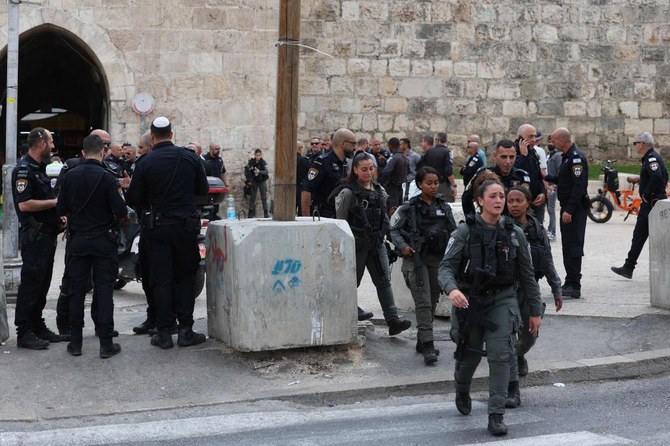
- Al-Foul was “treacherously ... targeted in his car” without provocation, the brigades said in a statement. “This crime is just like any assassination by Israeli special forces.”
RAMALLAH: Palestinian security officers killed a gunman in the occupied West Bank on Thursday, a rare intra-Palestinian clash whose circumstances were disputed and which the fighter’s faction described as an Israeli-style “assassination”.
Palestinian Authority security services spokesperson Talak Dweikat said a force sent to patrol Tulkarm overnight came under fire and shot back, hitting the gunman. He died from his wounds in hospital.
Videos circulated online, and which Reuters was not immediately able to confirm, showed a car being hit by gunfire.
A local armed group, the Tulkarm and Nour Shams Camp Brigades, claimed the dead man, Ahmed Abu Al-Foul, as its member with affiliation to the largely militant group Islamic Jihad.
Al-Foul was “treacherously ... targeted in his car” without provocation, the brigades said in a statement. “This crime is just like any assassination by Israeli special forces.”
President Mahmoud Abbas’ PA wields limited self-rule in the West Bank, and sometimes coordinates security with Israel.
Parts of the territory have drifted into chaos and poverty, with the PA and Israel trading blame, especially since ties have been further strained by Israel’s offensive in Gaza.
Hamas, an Islamic Jihad ally which rules the Gaza Strip and has chafed at Abbas’ strategy of seeking diplomatic accommodation with Israel, denounced “the attacks by the PA’s security forces on our people and our resistance fighters”.
Palestinian security forces and gunmen have exchanged gunfire several times in the last year, but deaths are rare.





